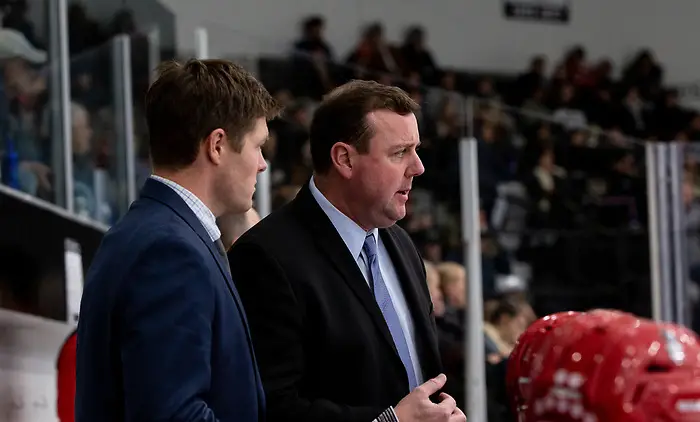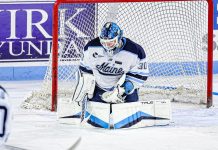
Each week during the season, we look at the big events and big games around Division I men’s college hockey in Tuesday Morning Quarterback.
Paula: A very happy new year to you, Jimmy, and to all of our readers.
We’re in the middle of that weird midwinter interlude with tournaments, nonconference play, the World Juniors and some league play starting up this Friday.
The most interesting hockey of the last weekend may have come in the three tournaments captured by the host teams. In the Mariucci Classic, first St. Cloud State stunned Minnesota State 7-2 in the opening round. After Minnesota beat Bemidji in the first game, the Golden Gophers held the Huskies to a single goal and won the tournament for the first time since 2012. It’s especially good to see for the Gophers as this was the tournament’s return after a two-year break.
I’ll wager that few people had Dartmouth winning the Ledyard Bank Classic for the first time since 2015 – especially sweet for the Big Green as they have been the second-place team for the last three years running – and with two shut-out wins, Vermont captured its second straight Catamount Cup.
Saturday’s 2-0 win over Union snapped Vermont’s 12-game winless streak (0-10-2) that dated back to Oct. 25., and the two wins on the weekend are just the second and third of the season for the Catamounts.
Here’s an interesting note: Vermont senior goaltender Stefanos Lekkas has shared the net with no one this year, and all three of his wins have been 2-0 shutouts.
We’ve seen midseason conference success give a team a boost in the second half but, with all due respect to the Catamounts, we’ve rarely seen a team redeem its whole season after a seriously bad first half.
What do you make of what you’ve seen from the weekend, Jimmy?
Jim: I do remember when Northeastern entered the Friendship Four in November 2015 and, after winning the consolation game of that tournament, went on a roll and won the Hockey East tournament for the first time since 1988.
Could that be a similar fate for Vermont?
Likely not.
And I don’t want to disparage this Catamount team as it has a top-notch goaltender in Stefanos Lekkas. He posted two shutouts this weekend, but unfortunately, the Catamounts needed every one of those saves as they scored just a single goal in each game (outside of empty-netters).
But, certainly, teams can use the break and, subsequently a fast start after, to reinvigorate their season. The one thing that almost every team benefits from during break is the ability to rehab. Bumps and bruises often become resolved over a break to place impact players back into a lineup. That can often give a team enough depth to turn a one-goal loss into a win.
To me, that is the most critical impact that a break can have.
Paula: You bring up depth here, and that’s something I’ve been thinking a lot about lately while watching programs in the Big Ten rebuild.
Depth, age, experience – varying kinds of experience – all of these things factor so much into the difference between winning and losing those one-goal games. Healing up after a break helps, certainly, but offensive depth seems to be a thing that is lacking in recent seasons. There aren’t many teams that can look beyond their first lines for solid, reliable, consistent offensive production.
I know that in some programs – and not just in the Big Ten – early departures contribute to this. In others, it’s a rebuilding process with new or newer coaches, maybe teams with younger rosters. I wonder if we’re seeing a period in college hockey overall in which depth is an issue. The rest afforded by a midseason break to heal up key players is good for the second half, but the bigger picture remains.
Looking back at the last decade, there has been so much change in college hockey. Beyond realignment, we’ve seen so many coaching changes, significant changes in the ways teams study and prepare for games, changes to the ways players remain prepared and connected during the offseason. Are there fewer teams with real depth, or am I looking back through nostalgia-colored glasses?
Jim: I’m not sure that I see a constant that can be painted with a broad brush-stroke when it comes to depth.
If anything, the way leagues now approach game management has made depth a different situation.
Going back 10 years, very few games were televised in many leagues. The old WCHA had the broadest TV contract. Now, though, every team or league may not have a TV contract, but with the expansion of online streaming and school-created television content, each and every league has a mandated “media timeout” policy. That has changed the need for depth.
When you look at TV timeouts, basically every five minutes in the game, teams get a two-minute timeout that allows coaches to reset their lines. Thus, if a coach chooses, you can cycle your top line onto the ice much more often, so much so that fourth lines could be practically unnecessary.
For coaches that once depended on having four workable lines, that isn’t as much of an advantage any longer (that said, wait until an NCAA tournament game that goes to overtime where TV timeouts aren’t allowed – then teams that have rolled four lines all game do have a distinct depth advantage over clubs that depend on TV timeouts in regulation to shorten their bench).
I don’t know that is a perfect reasoning for what is a perceived lowering in offense and, as we’ve termed it depth, since the beginning of 2010. But it certainly seems like a good starting point.
Paula: The game-management aspect is one thing I hadn’t considered, especially the concept of “the need for depth.” When depth becomes less necessary, a single good top line – with, perhaps, another scorer plus an offensive-minded defender for the power play – may be sufficient. That theory, Jimmy, is as good as any and good to ponder.
Switching gears a little bit, I wonder how much we jinxed Minnesota State after talking up the Mavericks as a team on the verge of domination. That 7-2 loss to St. Cloud wasn’t how they wanted to begin the second half, but the 2-0 recovery against Bemidji State was solid.
In spite of bookending their midseason break with losses, the Mavericks still earned two No. 1 votes in the USCHO.com Poll this week. I’m not surprised to see Cornell receive a couple, but there is no question that North Dakota is the team that everyone is chasing.
The Fighting Hawks begin the second half with a 13-game unbeaten streak (12-0-1). After having tuned up with a 3-1 win over the U.S. Under-18 Team Dec. 28, North Dakota faces Alabama Huntsville at home this weekend and plays 10 of its remaining 18 games at home. The Fighting Hawks have already faced four of their nine remaining opponents and were 7-0-1 in those games.
No. 2 Cornell heads to the Fortress Invitational (formerly the Ice Vegas Invitational) for a field that features three additional ranked teams: No. 6 Ohio State, No. 16 Providence and No. 20 Army. This looks like a great tournament to promote college hockey in a town that is already crazy about the professional game.
Jim: The Fortress Invitational certainly is the best field we have seen in any of these holiday tournaments.
Sure, maybe that’s a little bit of luck, but the tournament organizers also had pretty good insight that at least Cornell and Ohio State would be strong and made a decent bet that Providence would as well. The fact that Army has become a dominant team and cracked the top 20 is gravy.
Having a field with four top 20 teams is just incredible. I will be out there and look forward to two days of great hockey in a unique city for college hockey.
That tournament will conclude a very exciting two weeks for hockey in the west. This past weekend, Harvard and Arizona State faced off in the SoCal Clash in Irvine, Calif. I was lucky to be at both of those games and was impressed for the appetite for college hockey in a state that hasn’t hosted a single NCAA game since the 1999 Frozen Four in Anaheim. Both games were sold out this weekend, with standing room tickets sold each day.
Additionally, the venue also had three other ice sheets that were packed with hundreds of youth hockey players of all ages.
My biggest take away is how hockey hungry that geographic area of the country is right now. And it seems to me, if college hockey wants to expand, going west is most certainly a good bet for the future.


